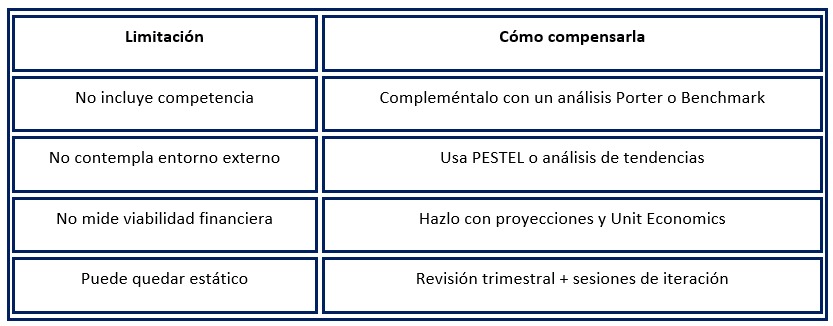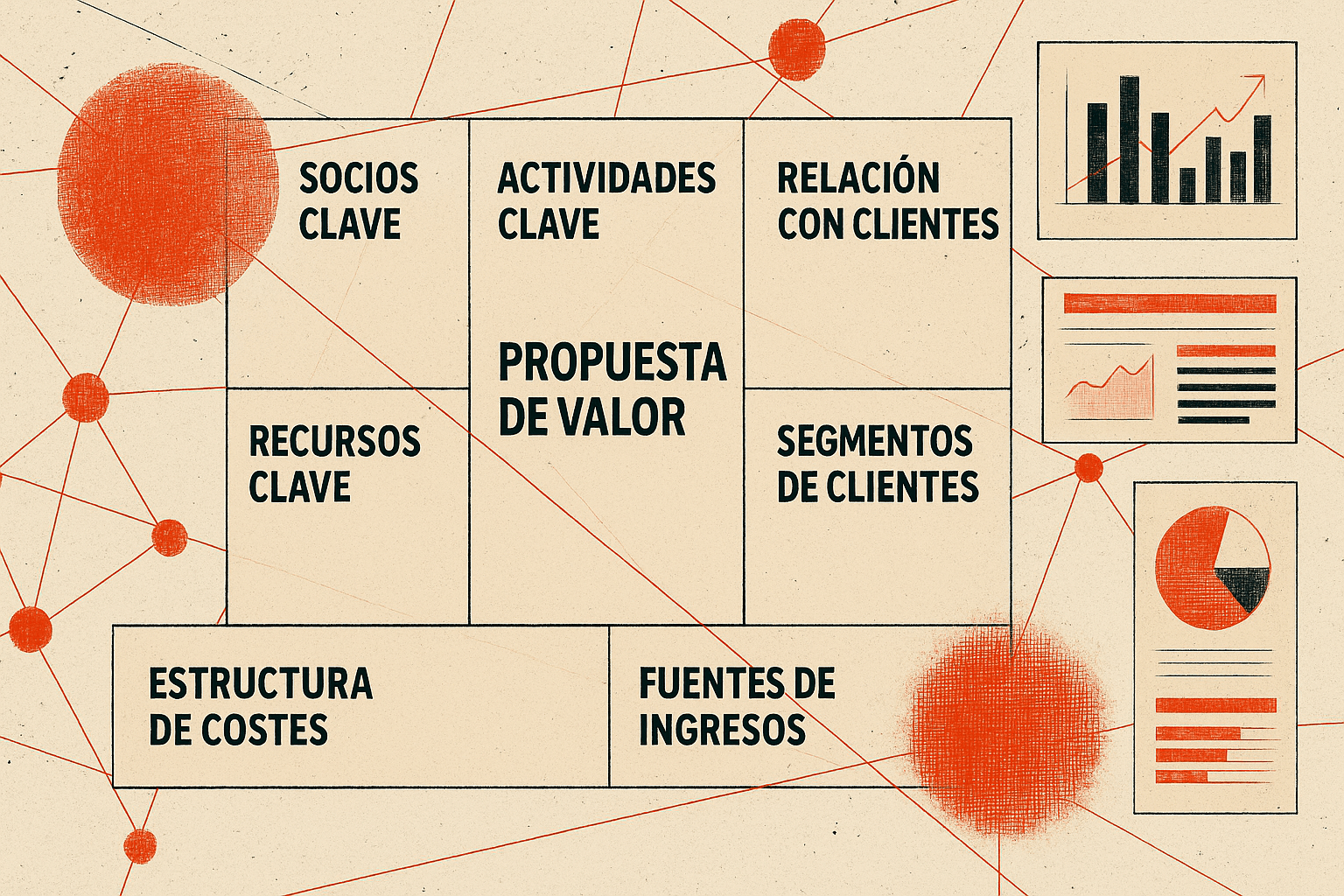In an environment where speed and uncertainty constantly challenge organizations, having a tool to visualize the business as a whole becomes indispensable. The Business Model Canvas not only facilitates this panoramic vision, but also enables relevant conversations between teams, accelerates decision-making and aligns efforts around a common logic: how do we generate, deliver and capture value in a coherent way?
For SMEs and startups, in particular, it represents a unique opportunity to get out of autopilot and rethink their proposal in a structured way, without falling into eternal business plans that become obsolete before being implemented. The Canvas proposes agility without losing depth. Its real purpose is not only to describe a business model, but to become a tool for strategic reflection, continuous validation and sustainable growth.
What is the purpose of making a Business Model Canvas?
The BMC serves to align vision, strategy and execution on a single sheet. Its purpose is not simply to “document,” but to help:
1. To visualize the business model in an integral way.
When many areas work in isolation (product, marketing, sales, logistics), it is easy to lose sight of how they fit together. The Canvas breaks down silos, showing how value is created, delivered and captured from a systemic view.
Encourage innovation and change
Unlike a traditional business plan, the BMC is quick to modify, making it an ideal platform for testing hypotheses, launching new models, detecting opportunities and pivoting.
3. Making strategic decisions
When you have a business that works “on automatic”, many decisions are made based on intuition or urgency. The Canvas forces you to review each block with a critical eye, which facilitates coherent and sustainable planning.
4. Facilitate internal and external communication
Whether presenting to an investor, aligning the team, adding a partner or working with a consultant, the Canvas works as a common language that synthesizes the essentials without unnecessary technicalities.
Who should use the BMC?
Although it was originally intended for startups, its use today is transversal. It is used by:
- Industrial SMEs that want to redefine their value proposition
- Consultants seeking new customer segments
- Family businesses in the process of digital transformation
- Technology startups in the scaling stage
- Innovation teams in large corporations
- Freelancers or solopreneurs who want to think of their business as a system
The BMC is particularly useful in times of change: launch, expansion, digitalization, crisis or strategic relaunch.
How to build each block of the Business Model Canvas
Below, we delve into how to approach the construction of each block, with practical tips:
1. Customer Segments
🔍 Key questions:
- Who do you really help?
- Which customer groups are most valuable to your business?
💡 Tip: Use real data. Segment by behavior, need or value generated. Avoid generic definitions such as “companies” or “users”.
Learn more about Ideal Customer Profiles in our article. “Ideal Customer Profile (ICP) and why it is key to your business strategy.”
2. Value Proposition
🔍 Key questions:
- What problem do you solve?
- What need do you fill better than anyone else?
💡 Tip: Think about functional (speed, price, convenience) and emotional (status, security, identity) benefits. Use the Value Proposition Canvas as a complementary tool.
3. Channels
🔍 Key questions:
- How do you deliver value?
- What channels are most effective to reach and serve?
💡 Tip: Differentiate between communication channels (networks, ads), distribution (platforms, physical) and after-sales (support, onboarding).
4. Customer Relationships
🔍 Key questions:
- What type of relationship does each segment expect?
- What do you do to acquire, retain and build loyalty?
💡 Tip: Explore automations, customizations and communities. It’s not all about customer service: it’s also about connection, trust and bonding.
5. Revenue Streams
🔍 Key questions:
- Why do your customers pay?
- How does money flow in your model?
💡 Tip: Include all sources: direct sales, subscriptions, licenses, commissions, upsells, etc. Think about dynamic pricing and freemium model if applicable.
6. Key Resources
🔍 Key questions:
- What do you need to operate?
- What assets set you apart?
💡 Tip: Don’t forget the intangible: brand, software, data, community. Classify into physical, human, financial and intellectual.
7. Key Activities
🔍 Key questions:
- What do you do every day that generates value?
- What processes are critical?
💡 Tip: Identify the value levers: production, development, marketing, distribution, support. Avoid confusing activities with objectives.
8. Key Partners
🔍 Key questions:
- Who helps you deliver value?
- What do you do with outside help that you couldn’t do alone?
💡 Tip: Think beyond suppliers: strategic alliances, brand ambassadors, communities, logistics or technology networks.
9. Cost Structure
🔍 Key questions:
- What are your most important costs?
- Which activities or resources consume the most?
💡 Tip: Classify between fixed, variable, recurring and non-recurring. Evaluate whether your model is “structure heavy” (hardware, equipment) or “light” (software, freelancing).
Tips for working on the Business Model Canvas in teams
- Use a large physical whiteboard or canvas in face-to-face workshops.
- It works with postits to allow flexibility and dynamism.
- On remote platforms, you can use Miro, Mural or Canva.
- Don’t go it alone: involve key areas (product, marketing, sales).
- Document and version: take pictures, keep copies. The model will evolve.
What to do after completing your Business Model Canvas?
Once you have it assembled:
- Validate it with real data
Go out and test it: interviews, surveys, pilots. Don’t fall in love with your hypothesis. - Design a validated value proposition
If a block does not fit, adjust without fear. Remember that the model is there to help you think. - Use it as a strategic roadmap
Priorities, investment, focus. Everything must align with what the Canvas tells you. - Integrate it into annual or quarterly planning
Convert each block into measurable objectives and actions.
Limitations of the Business Model Canvas (and how to overcome them)

Future perspectives: BMC in the era of AI and constant change.
The Business Model Canvas is still valid, but it is evolving. Some current trends:
- Integration with generative AI: to propose automatic hypotheses or analyze behavioral changes.
- Testing automation: tools that allow you to run A/B tests of each block quickly.
- Fluid business models: flexible subscriptions, collaborative economy, blockchain.
- Adaptive Canvas: new versions include sustainability, social impact or data blocks.
The spirit of BMC remains the same: to help you think about how to generate, deliver and capture value. But the languages, tools and priorities evolve.
The Business Model Canvas is much more than a pretty template: it is a way to align vision, product, market and execution on the same plane. It is simple, but powerful. Visual, but strategic. Quick, but deep.
Whether you are launching a startup, redesigning a family business or looking to innovate within a corporation, the Canvas can help you clarify your ideas, make better decisions and clearly communicate your business model.
It does not replace in-depth analysis, but complements it. It does not work magic, but it does reveal the essential. Its true strength lies in making the invisible visible.
Do you want to build or update your Business Model Canvas with strategic guidance?
At Smart Team we help you turn your business vision into a clear, coherent and ready to scale model.
Consultor de Marketing y SEO con más de 10 años de experiencia en optimización web y estrategias digitales. Ayudo a negocios locales, pymes y grandes empresas a mejorar su posicionamiento online, alcanzar sus objetivos de crecimiento y adaptarse a un mundo digital cada día más competitivo.



